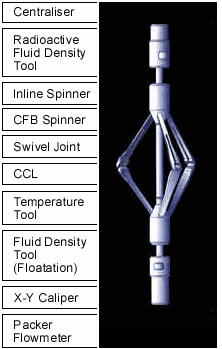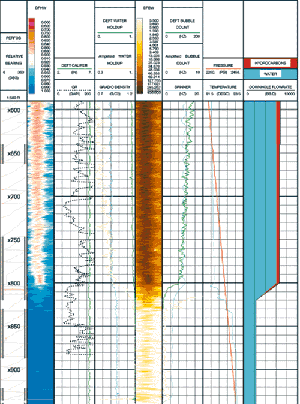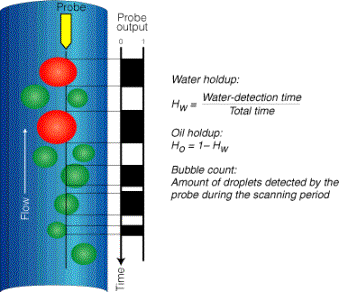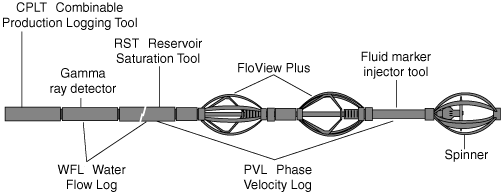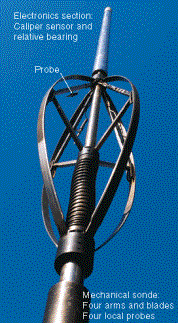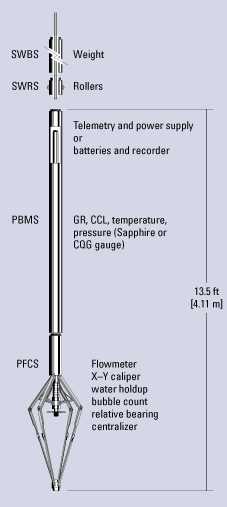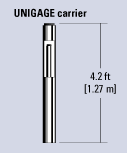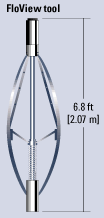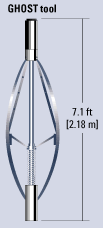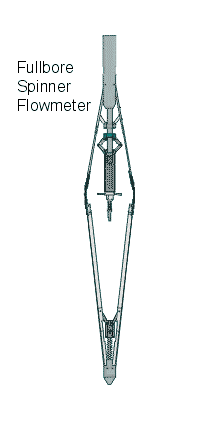Production Logging
What
Is Production Logging?
Production
logging consists of running logging tools in both production and injection
wells. They can be run under dynamic
(flowing) or static (shut in) conditions.
With proper interpretation, production type, production intervals, and
flow rates can be determined.
Production logging can be identify:
1. Water
entry/exit locations and sources
2. Non-performing
perforations
3. Flow
behind casing or tubing
4. Crossflow
5. Leaks in
tubing or casing
6. Unproductive/receptive
intervals for stimulation
7. Packer
leaks
8. Lost-circulation
zones
You may
use PL on your injectors or you may use it on producers that are communicating
with or in the vicinity of injectors.
For this reason, the discussion is kept generic, at least initially, so
that the relevant concepts for either application can be appreciated. Typical components in PL surveys are
summarized below. There are variations
in the degree of sophistication of these measurements (and tool configurations)
from vendor to vendor but the concepts remain the same.
Temperature
The
temperature sensor measures the temperature of the borehole. Temperatures logs were one of the first
production logs and are still widely relied on today to qualitatively (and
sometimes quantitatively) yield a variety of information. One of the primary uses is for fluid entry
identification from the change in temperature that normally occurs when fluids
from different depths enter a wellbore during production or enter the formation
during injection. Temperature can be
used for injection evaluations although interpretation can be difficult.
Temperature
logs can indicate flow behind casing or tubing, such as channeling (use
standard surveys as well as warmback measurements!). Other applications include locating gas entries, defining lowest
point of production or injection, identification of casing, tubing, or packer
leaks, checking gas-lift valves, defining the geothermal gradient, locating
lost-circulation zones, determining hydraulic fracture height (approximately at
least), and defining cement placement and top.
Pressure
The
pressure sensor measures the pressure in the borehole on a depth-to-depth
basis. While logging, change in
pressure versus change in depth is used to determine the pressure gradient (and
consequently density) in the wellbore.
This can be used to identify gas, oil and water interfaces during
production. The pressure sensor can
also be used to determine wellbore pressures for critical well control
applications, to evaluate friction losses and for a early time buildup when
well is shut-in prior to making shut-in logging passes. As a fluid density device it can be used for
fluid identification, fluid entry or exit point determination and water holdup
determination if there is gas production.
Spinner
Flow
along the wellbore is measured, commonly with a spinner. The spinner is a fan blade type device that
is rotated by the fluid movement in the borehole. Many new-generation spinners have diagnostics that determine the
flow rate and flow direction and also detect any problems in the system and
will correct the flow rate automatically if there is a tool error.
The
spinner response is typically linear with production velocity, but is offset
from the zero point. This is due to the
friction in the spinner's bearings as well as the viscosity of the production
fluid and is called the spinner threshold.
To get good results from the spinner survey, the borehole flow rates
should exceed some minimum value (e.g. 10 feet per minute in fluid or 28 feet
per minute in gas). Charts are
available to convert production in barrels per day to flow rates in different
sizes of pipe. The tool velocity also
adds or subtracts from the spinner rate and is used to calibrate the spinner
and determine the spinner threshold. Line
speed is a critical component in most production logging. It is important to remember that the spinner
is only indicating what is happening in the borehole where the spinner is
positioned and that the production dynamics of boreholes may vary greatly,
causing the spinner to sometimes give unreliable results especially in
multi-phase wells.
Dielectric (Water Holdup)
This is
used for inferring components in the production stream and, for PWRI, would be
more useful in an offset producer where water cut has increased. This is also referred to as the capacitance
sensor and measures the dielectric constant of the fluid in the borehole. Since the dielectric constant of water is
high (about 80) and that of oil and gas is low (2 -6), this sensor is used to
determine the fluid type, namely hydrocarbon or water. This sensor compliments the pressure
gradient. The difference in the
pressure gradient between oil and water is very small (0.09 psi), but the
dielectric values are greatly different, making the capacitance tool very
sensitive to small amounts of water.
However, the capacitance sensors response to percent of water mixes is
not linear and when water becomes the dominant percent of the mixture it becomes
difficult to discriminate any the percent of water and oil in the mix (some
sources indicate that the oil cut needs to be greater than 3% to be detected).
Gamma Ray
As is
well known, the gamma ray sensor measures natural radioactivity. The gamma ray is mainly used for adjusting
the depths of the production logs with other logs to a common basis. The gamma ray can also be used to follow
injected radioactive material in the borehole to determine flow profiles and
velocities and can be used to trace frac sand that has been tagged with radioactive
material.
Casing Collar Locator
(CCL)
The
casing collar locator (CCL) measures magnetic anomalies induced by changes in
metallic mass in the borehole. It is
also used as a means of depth correlation and can be used to locate
perforations, packers, x nipples, gas lift valves, screens, and other
mechanical components in the borehole.
Vendors
PL tools and services are
offered by a variety of vendors – with broad geographical coverage and levels
of sophistication. Appendix A is an
audit of some of these service providers.
It is only a partial list of vendors.
The products and services of the following vendors are summarized in the
Appendix. More information is available
from these service companies.
Vendors
(refer to Appendix A)
|
Company |
Location |
URL |
|
Baker
Atlas |
Worldwide |
http://www.bakerhughes.com/bakeratlas/reservoir_production/polaris_index.htm |
|
Cardinal
Surveys Company |
Odessa,
TX, Hobbs, NM |
|
|
Expro
International Group PLC 2001 |
Aberdeen
and other offices worldwide |
|
|
Halliburton |
Worldwide |
http://www.halliburton.com/spe98/flow2000.asp
|
|
Kuster
Company F.T.I. Inc. |
Long
Beach, CA and other worldwide offices |
|
|
Lee Tool Division of
Schlumberger Canada Ltd. |
Red Deer, Alberta |
|
|
Madden
Systems Incorporated[1] |
Odessa,
TX; Houston, TX; |
|
|
Maxim
Technology Limited |
Wales,
UK |
|
|
Oildata
Wireline Services Limited |
Port
Harcourt, Nigeria |
|
|
Read
Well Services |
Bergen,
Norway; Aberdeen,
UK; Doha, Qatar |
|
Schlumberger
|
Worldwide |
|
|
Spartek
Systems |
Sylvan
Lake, Alberta |
PWRI Specific Issues:
Many of the specific
difficulties occur when logging in horizontal or high angle wells, especially
if there are multiply fractured zones.
Warmback measurements can help to discriminate what the true entry point(s)
is (are).
Appendix A
PLT Service Providers
Baker Atlas
http://www.bakerhughes.com/bakeratlas/reservoir_production/polaris_index.htm
POLARIS System
|
|
The Baker Atlas
POLARIS System is a combination of the Reservoir Performance Monitor (RPM)
and Multi-Capacitance Flow Meter (MCFM) logging tools – a slimhole diagnostic
system for evaluating and understanding horizontal well and reservoir
performance. |
Reservoir Performance Monitor (RPM)
This
is a slimhole (1.7-in. OD) multi-function pulsed neutron tool. The RPM instrument combines multiple nuclear
measurements in one system.
Carbon/Oxygen (C/O) and pulsed neutron capture (PNC) measurements
acquired with the RPM tool provide water saturation and three-phase holdup
determination while oxygen activation measurements allow water flow and channel
detection. The small diameter
instrument addresses a broad scope of reservoir evaluation and management
applications, including reservoir saturation and produced fluids monitoring,
formation evaluation, production profiling, workover and well abandonment
evaluation, borehole diagnostics, locating bypassed oil, and identifying water
production.
Multi-Capacitance Flow Meter (MCFM)
A
multiphase production logging tool for non-vertical wells. The small diameter, multiple-sensor MCFM
instrument incorporates technology for measuring three-phase flow – oil, water,
and gas – in horizontal, highly deviated, and undulating wellbores. The combination of an across-the-wellbore
capacitance array with temperature, pressure, and acoustic sensors allows the
MCFM instrument to pinpoint the location of three-phase fluid entry into the
wellbore. The MCFM tool can
simultaneously measures all three phases in multiphase flow.
With
most production problems, the location of unwanted fluid production is of
primary interest. However, to
completely solve the production problem, the source as well as the location are
needed; e.g., whether it is due to cresting or coning, depletion, fingering,
injection breakthrough, fractures or faults, or behind-casing flow. The POLARIS system, combining RPM and MCFM,
can go to the region of unwanted fluid production and operate in a
high-resolution logging mode to identify both the location and source of the
unwanted fluid.

Measurement
of multiphase flow behavior and inflow profile determination in horizontal
wells is possible with the Multi-Capacitance Flow Meter Service.
Polaris Applications
·
Reservoir monitoring and management
- Establish base logs and monitor fluid
contacts, production, reservoir depletion, and fluid movement
- Evaluate and manage enhanced oil recovery
projects
·
Formation evaluation
- Determine reservoir porosity and fluid
saturations
- Pinpoint bypassed reserves
- Through-casing or drillpipe evaluation
- Production profile
- Determine borehole fluid holdup and
distribution, regardless of well deviation
- Evaluate injection or production profiles in
multiple string completions
·
Workover access and evaluation
- Identify bypassed hydrocarbons and establish
fluid contacts
- Slimhole access without compromising
measurement quality
- Evaluate stimulation operations
- Borehole diagnostics
- Identify casing leaks, water channeling, and
other behind pipe water flow
- Resolve completion problems
·
Pre-abandonment well evaluation
- Identify and assess commercial value of
bypassed hydrocarbons prior to well abandonment
- Locate trapped hydrocarbons between tubing
and casing strings for thorough environmental evaluation
Features
and Benefits
The RPM instrument can be run in
combination with the MCFM tool or with conventional production logging sensors
such as flow meters, temperature, fluid density, pressure, and hold-up
indicators. This combination flexibility
provides a complete multimode, multi-sensor solution-based system for a wide
range of downhole reservoir conditions and production environments.
The RPM
instrument is the industry’s most extensively characterized multimode tool,
with our unique dynamic response generator providing superior measurement
accuracy and confidence, independent of borehole geometry. Major advances in full 3-D and Monte Carlo
modeling provide a more accurate tool response characterization in a wide range
of borehole, casing, and formation/ fluid conditions.
Real-time
RPM data can be matched with previous generation PDK-100 results for easy
comparison in mature fields. For remedial work and time-lapse monitoring, RPM
data can be overlaid with existing logs in real time. An advanced feature of the RPM service allows real-time
computation of "intrinsic" ![]() . Innovative data analysis techniques provide
this sigma measurement corrected for borehole and diffusion effects without
prior knowledge of borehole size and fluid salinity. RPM corrected
. Innovative data analysis techniques provide
this sigma measurement corrected for borehole and diffusion effects without
prior knowledge of borehole size and fluid salinity. RPM corrected ![]() values
can be directly compared with borehole and diffusion corrected data from
PDK-100 or other PNC tools.
values
can be directly compared with borehole and diffusion corrected data from
PDK-100 or other PNC tools.
A History of Innovative Firsts in Pulsed Neutron Logging
Dresser Atlas, a predecessor of Baker Atlas, introduced the
first commercial pulsed neutron logging tool in 1963. The Neutron Lifetime Log® service
proved to be very successful for determining water saturation in
saltwater-bearing reservoirs.
In the
mid 1970s, Baker Atlas introduced the first
commercial Carbon/Oxygen log. The primary application of this
logging system was to determine water saturation in fresh, brackish, or mixed
salinity reservoirs.
Over the
next two decades, Baker Atlas introduced a second-generation pulsed neutron
log, the PDK-100 (1985),
the HydrologSM
(1989) and the Annular
Flow Log (1993). Another innovation, the Pulsed Neutron Holdup Imager, was
introduced in 1994.
In 1999,
Baker Atlas introduced the Reservoir
Performance Monitor (RPM) instrument, a multipurpose, pulsed neutron logging
tool. The new system
combines the measurement capabilities of all previous pulsed neutron devices
into one slimhole instrument, providing greater measurement flexibility than
ever before and setting the new standard for reservoir evaluation and analysis.
The POLARIS system, which incorporates the
Reservoir Performance Monitor (RPM) and Multi-Capacitance Flow Meter (MCFM),
was also introduced in 1999.
|
Application |
Operating Mode |
|
|
Formation evaluation (fluid saturations and porosity)
|
PNC, C/O |
|
|
Time-lapse fluid monitoring |
PNC, C/O |
|
|
Production/injection profiling |
PNC, C/O, PNHI, MCFM, AFL |
|
|
Evaluation of stimulation operation |
PNC, C/O, PNHI, MCFM, AFL, PRISM |
|
|
Hydrocarbon location in fresh, brackish, or unknown water
salinities |
C/O |
|
|
Bypassed hydrocarbon exploration in abandoned or workover wells |
PNC, C/O |
|
|
Production and reservoir depletion monitoring |
PNC, C/O, PNHI, MCFM |
|
|
Enhanced oil recovery project monitoring |
PNC, C/O |
|
|
Reservoir gas/oil/water contact monitoring |
PNC, C/O, PNHI, MCFM |
|
|
Future reservoir management base logs |
PNC, C/O |
|
|
Log-inject-log operations |
PNC, C/O |
|
|
Water channeling and/or casing leak identification Hydrolog |
AFL |
|
|
Water, oil, and gas holdups |
PNHI, MCFM |
|
|
Multiple string completion injection and production profiling |
AFL |
|
|
Hydrocarbon typing – differentiation between gas and oil |
PNC |
|
|
Locating trapped hydrocarbons between tubing and casing strings |
C/O, PNC |
|
Instrument Specifications |
||
|
Diameter |
1.6875 in. |
42.9 mm |
|
Length |
80 ft. |
24.4 m |
|
Weight |
375 lbm |
175 kgm |
|
Pressure Rating |
15,000 psi |
103 MPa |
|
Temperature Rating |
350° F |
177° C |
|
Min. Hole Size |
> 1.8 in. |
> 45.72 mm |
|
Operating Range |
3.7 - 9.0 in. |
94 - 229 mm |
|
Max bend radius |
30°/100 ft |
30°/30 m |
Multi-Capacitance
Flow Meter (MCFM)
System Overview
The
Multi-Capacitance Flow Meter (MCFM) is a multiple-sensor, production logging
instrument used to measure multiphase flow in highly deviated and horizontal
wells. The MCFM tool was jointly
developed by Baker Atlas and Shell International Exploration and Production
(SIEP) using technology developed by SIEP for monitoring multiphase flow in
surface flow lines.
The MCFM
deploys a wing containing 28 capacitance sensors that span the wellbore to
determine both flow composition (percentages of gas, oil, and water) and
velocity in order to measure flow rates (Qg , Qo , and Qw
).
The wing
section is dynamically oriented by the powered Positive Orientation Section
(POS) to ensure optimum vertical positioning, thus allowing the tool to
accurately measure three-phase flow, even in extremely high water cut
environments.

The wings of the MCFM tool are maintained in the
vertical position to measure multiphase flow behavior in horizontal wellbores.
A quartz pressure sensor is included in the MCFM
instrument to determine downhole pressures, and allow pressure surveys to be
carried out while an evaluation program continues, e.g., performing a shut-in
pressure survey.
|
Digital Sonan sensors also form an integral part of the MFCM diagnostic measurements, aiding in-flow regime identification and verification, channeling assessment, and flow behind pipe. Key Measurements
The
MCFM tool is a logging instrument capable of measuring all three phases –
oil, water, and gas – simultaneously. |
|

An across-the-wellbore velocity profile is
constructed from the transit-time measurements of the capacitance sensors in rows
one, two, seven, and eight of the MCFM tool.
Reservoir
Performance Monitor
System Overview
The RPM
instrument employs three high-resolution gamma-ray detectors arrayed above a
new, more efficient and reliable neutron generator. State-of-the-art detector electronics measure both the arrival
time and energy of detected gamma rays.
The generator is pulsed at distinct frequencies and the detectors
operate in various acquisition modes to obtain the different logging
measurements. The system is combinable
with other production logging instruments, and is constructed in short, modular
sections for ease in shipping and handling.
Operational Modes
Carbon/Oxygen spectroscopy mode –
principal measurement is the C/O ratio.
The neutron generator pulses at 10 kHz in the C/O acquisition mode with
the full inelastic and capture gamma ray energy spectra recorded by each
detector. These data are processed to
determine critical elemental ratios, including carbon/oxygen and calcium/silicon
from the inelastic spectra and silicon/calcium from the capture spectra. Data from each detector may be used
individually or in combination to provide optimal readings. C/O interpretation includes a new dynamic
response generator to accurately predict the expected C/O response level-by-level
in your well.
Pulsed Neutron Capture mode –
principle measurement is sigma, the thermal neutron absorption cross
section. In the PNC logging mode, the
neutron generator pulses at 1 kHz while the detectors record complete time
spectra, and an energy spectrum, used to monitor instrument stability. Time spectra from short-spaced and
long-spaced detectors can be processed individually to provide traditional
thermal neutron capture cross-sectional information. The two spectra can also be processed simultaneously to
automatically correct for borehole and diffusion effects and produce results
very near the intrinsic formation values.

RPM instrument principle of
operation- inelastic events; shown in yellow, occur during the generator
burst. Capture events, shown in blue,
occur after the neutrons become thermalized.
|
Instrument Specifications |
||
|
Diameter |
1.6875 in. |
42.9 mm |
|
Length |
29.9 ft |
9.12 m |
|
Weight |
115 lbm |
52.3 kgm |
|
Pressure rating |
20,000 psi |
138 MPa |
|
Temperature rating |
350° F |
177° C |
|
Minimum hole size |
> 1.8 in. |
> 45.72 mm |
|
Maximum bend radius |
30°/100 ft |
30°/30 m |
|
Pulsed Neutron Holdup Imaging mode measures
both sigma and the C/O ratio In
the PNHI acquisition mode, the neutron source pulse rate is also l kHz with
the measurements made to determine gas, oil, and water holdups. When combined
with other production logs, the PNHI can provide a comprehensive downhole
production profile picture, even in deviated or horizontal wells. Neutron activation mode measures
water flow oxygen activation The
neutron activation mode provides water flow measurements using one of several
data acquisition methods. Stationary measurements are made in either of two
operating modes. Measurements at selected logging speeds can be used to
segregate different flow rates in either an annulus or in an adjacent tubing
string. Precision Radioisotope Spectral
Measurements mode provides radioisotope identification and measurement With
the neutron generator turned off, the RPM tool can also be used to detect the
distribution of materials, tagged with radioactive tracers that are injected
into a well during stimulation treatments. In this logging mode, the
effectiveness of operations such as hydraulic fracturing or gravel pack
placement can be evaluated.
|
|
Cardinal Surveys Company
Odessa,
TX, Hobbs, NM
http://www.cardinalsurveys.com/default.asp
|
Positive monitoring of reservoir performance. |
|
|
|
Detailed, zone-by-zone, information. |
||
|
Changes in the downhole conditions detected. |
||
|
Reevaluate marginal production wells. |
||
|
Rework watered-out or gassed-out wells. |
||
|
Recompletion of unproductive offset wells. |
||
|
Guidance for remedial-workover designs. |
||
|
Cost-effective well recompletions. |
||
|
Improved completion for future wells. |
||
|
Immediate verification of perforation efficiency. |
||
|
Positive identification of the production intervals. |
||
|
Confirmation of openhole log analysis and assumptions
used in the initial completion. |
||
|
Pinpoint mechanical problems. |
||
|
Document baseline production profile for future
reference. |
||
|
Optimize pump placement. |
||
|
Discover unwanted water sources for remedial procedures.
|
||
|
Correlate production results with injection profiles for
sweep efficiency of floods. |
||
|
Confirm engineering and geological assumptions and
analysis. |
||
|
Verify stimulation job effectiveness and techniques. |
||
|
Plan accurate placement of mechanical isolation tools
(bridge plugs and packers.) |
||
|
Locate thief zones and undesirable cross-flows. |
||
|
Real-time snap shot of production well. |
Components
- Rope Socket (15" - 5/8" fishing
neck)
- Capacitance
Tool (40") – Functions as a capacitor. An insulated probe functions as one plate and the tool
housing acts as the other plate.
Various materials passing between the plates have different
dielectric properties that change the total capacitance of the
circuit. In most instances, a 3%
or more oil cut is necessary before a noticeable change in the capacitance
is registered. This 3% threshold
varies with the salinity of the water and the gravity of the oil. The primary advantage of the
capacitance tool over the older density tool is that its readings are not
dependent on a radioactive source and sensor. Thus, fluid identification cannot be affected by radioactive
material in the well bore or in the ejector. In addition, there is no long
half-life source of radioactive material to be fished should the tools be
dropped.

- Caliper
(7/8" O. D. [with arms retracted] by 68" in length and can be
used in hole up to 14 inches in diameter.
- Collar Locator (7/8” x 28.5") – magnetic
coil assembly
- Scintillation Gamma Ray Detector
(60"). It is a scintillation
type 9sodium iodide crystal).
- Microprocessor Controlled Ejector
(75.5"). The ejector is
digitally controlled. Its motorized plunger forces small bursts of
radioactive material out of a pressure chamber through an o-ring sealed
exhaust port on the side of the tool casing. The tool has the ability to consistently eject selected
slugs from 0.1 cc to a full 20 cc ejector dump.
- Temperature Tool (7/8" O. D. by 37"
in length). Accuracy approaches
0.1 degrees Fahrenheit. This
component is critical for channel detection. There is a platinum Resistor Temperature Detector
(RTD). A stable crystal oscillator
serves as an accurate, drift-free frequency reference in the tool electronics.
- Memory Pressure Gauge (14”)
- Total Tool Length with crossovers = 30’
General Guidelines
Avoid the intentional design of
tests that rely completely on nuclear-based data acquisition. Their maximum
radius of investigation is approximately 24 inches from the sensor.
‘Avoid the LAST LOG
SYNDROME. It is generally acceptable
for most production logs to be within 2 to 3 feet of measured depth. However, if you are on the 4th or 5th
generation of logs, you may be correlating 10’ to 15’ off depth. Always try to use the original open hole
logs or the logs used to perforate the well.”
Tracer Velocity
|
|
Pros:
Cons:
|
Generic Operations
- The
producing (pumping) temperature log is the first information available for
determining the status of this well's production and it can greatly
influence the strategy for investigating the well.
- A
correlation gamma ray survey and collar log is then run from T.D. up
through zones of interest. The
correlation log is compared to file logs to make adjustments to depth.
- A
capacitance log is then run from T.D. to above the pump. The capacitance tool can differentiate
between water, oil, and gas in the well bore. Note that when calibrated, pure water is one extreme, pure
air or gas the other, and pure oil is about a 75% reading.
- The
next step is to run the radioactive tracer survey. The tracer will allow the determination
of the direction and rate of fluid movement. There are the three basic
components of the tracer: 100% shot, zone breakdown shots, and no-flow
shots. The 100% shot is ejected
above the top perforation. As the single radioactive slug travels up the
wellbore, at least three passes through the slug are recorded. By measuring the distance of movement
and the time of travel, it is possible to calculate the velocity and
therefore, the volumetric flow rate in the casing. This method of velocity measurement is
necessary because of pump surges in the fluid column. Stationary velocity readings are not
accurate. Zone-by-zone breakdown
is accomplished by the same velocity method as the 100% slug. Readings are taken in areas between
sets of perforations. Each set of
rates obtained is compared back to the 100% shot and a percentage of entry
is calculated for each set of perforations. A no-flow shot is ejected between the bottom perforation and
LTD. It is monitored in the same manner as the other velocity
measurements. The primary
objective is to determine if there is any fluid movement from below LTD in
the casing. This is essential
information. If the temperature
surveys indicate fluid movement from below LTD, the no-flow shot is the
only means to prove whether the movement is inside or outside the casing.
- The
log may or may not be complete at this point. After determining the type and quantity of fluid being
produced from each zone, decay temperatures and cross flow surveys may be
needed for further definition. It is almost always a good idea to run at
least one decay temperature survey unless all objectives for running the
survey have already been conclusively reached through the prior survey
methods.
GAMMA-TROL (Stimulation Evaluation Logging)
Combined with a radioactive tag, stimulation evaluation
logging assists in inferring treatment placement. Included in the service is either a temperature or gamma-ray log
or both. Cardinal Surveys Company
offers these services either separately or combined under the following names:
- Gamma-Trol
(Gamma-ray only)
- Temp-Trol
(Temperature only)
- Gamma-Trol
II (Combination
- Gamma
ray and Temperature).
The Gamma-Trol II service can
also be used to locate the top of cemented intervals. The cement can be tagged
during cementing, and the temperature and gamma ray log will accurately
pinpoint the cement top.
Injection Profile (Radioactive Tracer Profile Logging)
An accurate profile of the exact placement of injected
fluids is essential for proper management of water injection. The Injection Profile Log, usually
consisting of a temperature log, two radioactive tracer logs (the intensity
profile and a series of stationary velocity measurements), channel checks,
packer checks, injecting temperature log, shut-in temperature logs and
cross-flow checks (where applicable), can be used for getting profiles.
This log is used to determine the placement of injection
fluids in the formation. Of general
interest is a profile of the zone-by-zone placement of injected fluids versus
rate. A comparison of injection and
shut-in temperatures can be used to qualitatively determine major storage
(injected) zones.
In tertiary or Enhanced Oil Recovery (EOR) projects, the
injection profile is applied in a similar manner. Sometimes special logging techniques are required due to the
physical properties of the injection fluids.
Many tertiary or EOR projects alternate injection of multiple fluids
(Water After Gas-WAG, or vertical profile modifications such as polymer treatments). In these instances, it may be desirable to
log the well after each change in injection fluid to determine the relative
impact of different fluids.
Because a radioactive tracer is used, the Injection
Profile also affords other benefits such as location of casing annulus
channels. Channels in the casing
annulus can be seen when tagged fluid exits the casing through a perforation
and continues in a path near the wellbore.
The extent of the channel can be determined by following the tagged
fluid as long as it remains near the wellbore.
In a similar manner, communication between perforated intervals can be
discovered. The radioactive tracer
identifies other mechanical problems such as holes in the casing, unopened
perforations, leaking packers or bridge plugs.
“Due to the versatility of the radioactive tracer, it is
the best and most accurate method of running a Mechanical Integrity Test (MIT)
on disposal wells.” Using the same
logging procedures, the radioactive tracer can yield the zone-by-zone breakdown
of fluids exiting the wellbore.
Temperatures can also aid in identifying any upward or downward
channels.
TRAC-III
Production Logging
Cardinal's TRAC-III logging
string consists of a Scintillation Gamma Ray Detector,
(microprocessor-controlled) Radioactive Ejector, Collar Locator, Capacitance
Probe, Caliper, and Temperature Tool.
All sensors come in 7/8"
O.D., 1" O.D., 11/4"
O.D., and 13/8" O.D. cases. The tools are used to:
·
Document baseline production profile for future
references.
·
Verify effectiveness of well treatments.
·
Discover unwanted water sources for remedial procedures.
·
Correlate production results with injection profiles for
sweep efficiency of floods.
Well Parameters For Example
Procedure
|
Production |
20 BPD Oil |
210 BPD Water |
100 MCFD Gas |
|
Surface Pressure |
<300 PSI |
Casing |
5.5" |
|
Tubing |
2.875" |
Packer |
5500' |
|
Perforations |
5600' - 6000' |
PBTD |
6100' |
The following procedure
represents the fundamental steps needed to accomplish most TRAC-III
applications. However, due to the
investigative nature of production logging, it must be noted that the following
procedure may be modified at any point in order to optimize the definition of
events or abnormalities. This procedure should be considered as a general plan
of action.
1. Conduct
safety meeting to identify location hazards, review well information, review
test objectives, and make necessary plans to maximize safety and test results.
2. Rig up
Cardinal Surveys logging unit and conduct the pre-job wellhead radiation
survey.
3. Attach
Cardinal Surveys 1 3/8"
O. D. TRAC-III tool string which consists of a Rope Socket (1.375" x
15" with a 5/8" fishing neck), Capacitance Tool (1.375" x
40"), Caliper (1.375" x 69"), Collar Locator (1.375" x
28.5"), Scintillation Gamma ray Detector (1.375" x 60"),
Microprocessor Controlled Ejector (1.375" x 75.5") with I-131 as the
tracer isotope, and a Temperature Tool (1.375" x 37").
4. Install
5,000 psi lubricator and test for leaks.
5. Pressure
up lubricator and secure wellhead.
6. RIH with
TRAC-III tool string into the tubing.
7. Run Flowing
Temperature and CCL Logs from 5,400 to 6,100.
8. Run
Gamma ray and CCL logs from 6,100 to 5,400. Correlate Gamma ray and CCL logs to
supplied correlation log. Adjust depth measurement from Wireline Depth to
Measured Depth.
9. Return
TRAC-III logging string to T.D. at 6,100 and run Capacitance Log from 6,100 to
5,400.
10.
Return TRAC-III logging string to T.D. at 6,100 and run
Caliper from 6,100 to 5,400.
11.
Place TRAC-III logging string above the zone of interest
5600 - 6000 and eject a slug of radioactive material. As the slug travels up hole with the flow, make at least 3 passes
through the material with the recorder set to depth drive. Note the delta times from peak to peak. This
will allow for a 100% velocity reading.
12.
Repeat step 11 two more times.
13.
Repeat step 11 in areas between perforated intervals or
between areas of interest in the openhole section. Refer to the caliper results from 5600 - 6000 when placing the
radioactive slugs. Try to avoid areas
of drastic I.D. change to minimize the error in the velocity measurements.
14.
Eject a slug of radioactive material below the zone 5600 -
6000 and above T.D. at 6,100. Eject the
slug as low as possible if there is no rathole. Make several passes through the material to determine if there is
any flow coming from below T.D. in the wellbore.
15.
Shut-in production at wing valve.
16.
Allow the well to remain static for approximately one
hour.
17.
Run a Shut-In Temperature Log from 5,400 to 6,100.
18.
Perform crossflow checks.
Shoot a series of radioactive slugs approximately 50 feet apart across
the zone 5600 - 6000 and make timed passes through all of the slugs at the same
time to determine if there is any crossflow between zones.
19.
Run a Shut-In Temperature Log from 5,400 to 6,100 approximately
2 hours after the well has been shut-in.
20.
It may be desirable to pull a Shut-In Capacitance Log at
this point from 6,100 to 5,400.
21.
POOH with Cardinal Survey's TRAC-III production logging
tool string.
22.
Rig down equipment, return well to prior status, and
conduct the post job wellhead radiation survey.
Stabilization
Stable
producing conditions are crucial to running a TRAC-III that will give insight
to the wells normal production characteristics. This is important when the test objective is to see the well's
production profile. It is also important for determining the effects of a past
stimulation that is not performing as expected.
If we
run a TRAC-III immediately after the well has been worked over, it will only
tell us what the well does at that particular point in time. You want to allow the production to
stabilize, unless you have had a sudden, large increase in water production.
It does not matter if this increase of water production was
brought on by a stimulation, direct channel from an offset injector, or natural
causes. Don't wait for
stabilization. There is a strong
possibility this new water is from a higher pressure source than anything
you've been producing. In these
situations there is regularly crossflow into proven oil zones. It is necessary to find the water source so
that you can take remedial action.
GAMMA
TROL
GAMMA TROL - II is a combination
of Temperature and Gamma Ray logging used determine the placement of well
stimulations and treatments.
Well Parameters For Example Procedure
|
Frac |
140,000 lbm 20/40 |
BHT |
90oF |
|
Surface Pressure |
<3,000 psi |
Casing |
5.5" |
|
Tubing |
2.875" |
PKR |
5600' |
|
Perforations |
5700' - 6000' |
PBTD |
6100' |
The following procedure
represents the fundamental steps needed to accomplish most GAMMA TROL ®
applications. However, due to the
investigative nature of production logging, it must be noted that the following
procedure may be modified at any point in order to optimize the definition of
events or abnormalities. This procedure should be considered as a general plan
of action.
1. Conduct
safety meeting to identify location hazards, review well information, review
test objectives, and make necessary plans to maximize safety and test results.
2. Rig up
logging unit on and conduct the pre-job wellhead radiation survey.
3. Attach
Cardinal Surveys GAMMA TROL ® tool string which consists of a Rope Socket
(1.25" x 15" with a 5/8" fishing neck), one or more weight bars,
Collar Locator (1.375" x 28.5"), Scintillation Gamma ray Detector
(1.375" x 60"), and a Temperature Tool (1.375" x 37").
4. Install
wireline blow out preventer and tool trap.
5. Install
lubricator and test for leaks.
6. RIH with
GAMMA TROL ® tool string into the tubing.
7. Run Base
Temperature and CCL Logs from 5,500 to 6,100.
8. Run
Gamma Ray and CCL logs from 6,100 to 5,500.
Correlate Gamma ray and CCL logs to supplied correlation log. Adjust
depth measurement from Wireline Depth to Measured Depth.
9. POOH
with Cardinal Survey's GAMMA TROL ® production logging tool string.
10.
Rig down equipment, store lubricator in a safe area, and
stand by during well stimulation.
11.
Record ISIP and 15 minute shut-in pressures.
12.
Install wireline blow out preventer and tool trap.
13.
Install lubricator and test for leaks.
14.
RIH with GAMMA TROL ® tool string into the tubing.
15.
Run After Temperature and CCL Logs from 5,500 to 6,100.
16.
Run After Gamma ray and CCL Logs from 6,100 to 5,500.
17.
Allow well to remain static for approximately one hour.
18.
Run a Shut-in Temperature Log from 5,500 to 6,100.
19.
POOH with Cardinal Survey's GAMMA TROL ® production
logging tool string.
20.
Rig down equipment and conduct the post job wellhead
radiation survey.
Radioactive
Tagging
The Tagmaster ® was developed in
the late 1970's.
Downstream, High Pressure Tagging
Tagging
a treatment downstream of the pumps has many inherent advantages over injecting
radioactive material in the low-pressure pump intakes.
·
No
surface equipment (pumps, blender, manifold, etc.) has radioactive material
passing through it. This prevents a
buildup of contamination that will accumulate to a point where field personnel
will be exposed, not only to the radiation passing through the system, but also
to residual contamination from past tags.
These units can become too contaminated to be legally operated!

- The radioactive flush is instantaneous. There is no opportunity for any
particles to become trapped in surface equipment that might be released
during flush.
- If a frac treatment screens out to the
surface, all contamination will be downstream from the "T"
assembly.
- If there is a radioactive spill, it will be in
an area with no personnel in the immediate vicinity.
- Personnel exposure is kept to a minimum.
Placement
of Radioactive Storage
While
chronic exposure to low level radiation is hazardous, the immediate danger is
from exposure to the radioactive additive in concentration. Many systems store the radioactive additive
on, or near, charged fluid lines. If
the line should burst you could have a dangerous and expensive problem to
contend with. The Tagmaster ® stores
radioactive material in concentration 50 - 100 feet away from all treating
lines.
Storage
Containment
pots for the radioactive additive are mounted in the back-center of the
Tagmaster®. The pots are plastic
coated, steel containers that have approximately one inch of lead
shielding. This gives five half-value
layer shields for Iridium 192, the primary isotope used in the Tagmaster ®.
Professional
Tagging Technicians
All of Cardinal's technicians
have received government approved training programs. They are trained in the proper methods of containment, cleanup, A.L.A.R.A. techniques,
Cardinal's regulations, and government regulations concerning the
transportation, use, and exposure limits of radioactive materials.
Tagmaster
® Quality Control Log
The
Tagmaster ® Quality Control Log is an optional service offered by Cardinal
Surveys Company. It entails a PC based
data acquisition system that monitors radiation intensity of injected materials
during the stimulation.

RSO
Cardinal's Radiation Safety
Officer is responsible for safety, training, and regulatory compliance where
radioactive materials are involved. The
RSO maintains and reviews records of Before and After Location Surveys,
Personnel Exposure (whole body and thyroid bioassay), and monitors Cardinal
facilities.
He also holds a prominent
position in the Radiation Safety Committee. Records and procedures are
periodically reviewed by the committee to make changes where needed to enhance
our A.L.A.R.A.
program.
Isotope
Quality Control
Cardinal
has the majority of isotopes we use in the Tagmaster ® targeted by the Nuclear
Science Center at Texas A&M University.
Our control of materials supplied for targeting and follow-up testing,
with a state of the art 4096 channel spectrum analyzer, assures quality and
quantity control.
Tagmaster
® Specifications

·
4140 Carbon Steal "T"
·
Weco 1502 connections
·
20,000 psi working pressure valve
·
20,000 psi working pressure check valve
·
14,000 psi working pressure hose with 40,000 psi minimum
burst pressure
·
20,000 psi working pressure manifold
·
4 - Plastic coated, steal containment pots with 1" of
lead shielding
|
Isotope |
Atomic
Symbol |
Half-Life |
Special
Concerns |
Photo
peaks Mev |
|
Iodine |
131I |
8.04 days |
Thyroid Seeker |
9.99 (X-ray), 0.08, 0.2843, 0.3645, 0.638, 0.724 |
|
Iridium |
192IR |
74.2 days |
None |
0.067 (X-ray), 0.140 (Compton), 0.210 (Compton), 0.315,
0.470, 0.605, 0.79, 0.90 (shoulder) |
|
Scandium |
46SC |
83.8 days |
High Beta/Energy |
0.887, 1.119, (0.89 plus 1.1 sum peak) |
|
Antimony |
124SB |
60.2 days |
High Beta |
0.603, 0.645 (hidden shoulder), 0.722 (shoulder peak),
1.30 - 1.37, 1.69, 2.09, (1.69 plus 0.603 sum peak) |
|
Gold |
198AU |
2.696 days |
High Beta |
0.412 |
|
Bromine |
82BR |
35.34 hours |
High Energy |
0.55, 0.61, 0.7, 0.77, 1.04, 1.33, 1.48, 1.90, 2.14 |
Expro RAM Production Logging Tool
Expro
International Group PLC 2001
Expro North Sea Ltd
Kirkhill Place
Kirkhill Industrial Estate
Dyce
Aberdeen
AB21 0GU
Tel: +44 1224 214600
Fax: +44 1224 770295
http://www.exprogroup.com/casedholeservices/epl.htm
Introduction
In
1986, Expro performed the first memory PLT operations in the UK North Sea. Additional development led to the release of
the Expro RAM production logging tools in 1998.
The five main sensors - Gamma Ray, Collar Locator,
Quartz Pressure, High Resolution Temperature and Fluid Capacitance - are
contained in one assembly measuring only 55 inches (1.4 meters) long. This construction removes 8 electronic
pressure sealed connectors from the string therefore lessening the chance of
connector failure and improving overall reliability. The RAM tool is combinable with up to 9 additional sensors such
as calipers, fluid densities and extra spinners. However, in its normal deployment mode, with one spinner, the
total PLT length is 112 inches (2.85 meters) for surface readout and 138 inches
(3.5 meters) for memory applications.
Offshore, this compactness
allows deployment of PLT operations in the most restricted of areas and on land
eliminates the requirement of having large deployment cranes on site. It also means that the tool does not need to
be fully disassembled between jobs thereby reducing rig up and rig down time.
Applications
The RAM tool is a short,
all-in-one production logging tool, providing flow, quartz pressure,
temperature, fluid dielectric, gamma ray and CCL. Use of a single combination tool increases reliability by
minimizing electrical and mechanical connections, reduces rig up time, improves
data quality through the close proximity of all sensors and brings the benefits
of a smaller toolstring - allowing well access from even the most restricted of
areas.
In addition, the tool has the
ability to deploy 100% downhole backup while remaining shorter than most other
single toolstrings. A separate
telemetry cartridge connects to the upper head and is available in a number of
telemetry formats. A High Speed
Telemetry Cartridge (HSTI) or High Speed Memory Interface (HSMI) Cartridge can
be attached to the upper head. The RAM
is both memory and SRO compatible, requiring no separate interfaces or modules.
A range of industry-standard
sensors can be connected to the tool’s lower head - such as fluid density,
accelerometer, x-y-calipers, fluid profile, inline flowmeter or continuous
flowmeter. The high temperature and
pressure rating make the RAM tool suitable for a wide range of production
logging operations and its use results in a typical full-length string of only
112”/2.9m.
All tools are manufactured in
NACE specification (MR0175) materials for use in wells containing H2S/CO2
Flowmeter
Range
(Interface)........................................................ 30
- 60,000 bbls/day
Directional.............................................................................................. Yes
Resolution............................................................................. 12
pulses/rev.
Pressure
Type................................................................................................. Quartz
Range...................................................................... 15,000
psi - 16,000 psi
Accuracy...................................................................................... 0.02%
FS
Resolution.................................................................................. <0.008
psi
Repeatability................................................................................ 0.01%
FS
Temperature
Range............................................................................... 0
- 177°C/350°F
Accuracy..................................................................................... 0.5°C/1°F
Resolution.......................................................................... 0.025°C/0.05°F
Time
Constant............................................................................... <1.5
sec
Gamma
Ray
Range..................................................................................... 0
- 1,000 API
Sensitivity................................................................................. 1
Count/API
Fluid
Dielectric
Range............................................................................................ 0
- 40%
Accuracy..................................................................................... 2%
Range
Resolution........................................................................................... 0.1%
RAM Specification
Diameter |
13/8”
(35mm) |
111/16”
(43mm) |
|
Length |
55” (1.4m) |
55” (1.4m) |
|
Pressure (max) |
15,000 psi |
20,000 psi |
|
Temperature (max) |
177°C (350°F) |
177°C (350°F) |
|
Weight in air |
35 lbs (16 kg) |
52 lbs (23.6 kg) |
|
Fishing Strength |
10,000 lbs (4,550 kg) |
10,000 lbs (4,550 kg) |
|
Sensor Supply Voltage |
12v |
12v |
|
Line Voltage (SRO) |
60 - 250v |
60 - 250v |
|
Current |
80mA |
80mA |
Multi Sensor
Memory Production Logging Tool
The tool is able to operate in deviated or
horizontal wells and has the capability to log all types of multiphase flow and
can be deployed via slickline, coiled tubing or e-line. All of the MS-MPLT sensors are compatible
with the Expro RAM PL tools.
Applications
- Vertical,
deviated or horizontal wells
- Determination
of downhole flow rates
- Layering
- Zonal
distribution
- Crossflow
and leaks
- Multi-phase
flow
Technical
Specification
Memory |
|
|
Type |
Non-volatile EEPROM |
|
Size |
Expandable up to 16Mb |
|
Sample rate |
Multiples of 0.1 sec |
|
Data set |
Minimum of 30,000 on all channels |
|
Length / OD |
2ft / 111/16" (0.61m / 43cm) |
Full-bore Flowmeter |
|
|
Size |
Various for use in up to 95/8" casing |
|
Measurement range |
100 to over 30,000 bbl/day in 7" casing |
|
Length / OD |
2.95ft / 111/16" (0.89m / 43cm) |
In-line Flowmeter |
|
|
Size |
21/8" and 111/16" |
|
Measurement range |
600 to over 60,000 bbl/day |
|
Length / OD |
1.44ft / 111/16" (0.43m / 43cm) |
CCL |
|
|
Type |
Passive |
|
Length / OD |
1.53ft / 111/16" (0.46m /
43cm) |
Gamma Ray |
|
|
Type |
Scintillation |
|
Sensitivity |
1 cps / API unit |
|
Length / OD |
2.2ft / 111/16 (0.67m / 43cm) |
Water Hold-up |
|
|
Type |
Capacitance |
|
Measurement range |
0.01 to 1 (accuracy decrease at high values) |
|
Length / OD |
2.18ft / 111/16" (0.66m / 43cm) |
Pressure |
|
|
Type |
Shear quartz |
|
Accuracy |
± 3.2 psi (± 0.22 bar) |
|
Repeatability |
± 0.005% of full scale |
|
Length / OD |
1.02ft / 111/16" (0.29m / 43cm) |
High Resolution Temperature |
|
|
Type |
Platinum resistance |
|
Accuracy |
± 0.5ºC |
|
Resolution |
0.09ºC |
|
Length / OD |
1.02ft / 111/16" (0.29m /
43cm) |
|
All sensors are rated to 150ºC |
|
Radio Active Fluid Density |
|
|
Type |
Radio active source |
|
Length / OD |
2.18ft / 111/16" (0.66 /
43cm) |
X-Y Caliper |
|
|
Type |
4 arm |
|
Length / OD |
3.25ft / 111/16" (1m / 43cm) |
Halliburton
http://www.halliburton.com/spe98/flow2000.asp
Flow 2000 Production Logging
Services
In addition to the high-speed telemetry/gamma ray/casing collar locator cartridge, the Flow 2000 production logging stack includes the following sensors:
|
·
HMR Gauge Carrier
provides fast, high-resolution transient well testing with pressure
derivative in real time. ·
Capacitance Holdup Tool
identifies three-phase flow with low water cuts. ·
Gas Holdup Tool provides fullbore gas
holdup from low energy gamma ray scattering in fluid and steel pipe. ·
Differential Pressure Tool
determines liquid holdup and identifies fluid in wellbore deviations up to
70°. ·
Six-Arm Fullbore Spinner
measures mono- and multi-phase flow with a threshold above 100 BFPD (in 7-in.
casing). ·
Enhanced Flow Diverter for
multiphase production or injection flow rate measurements and enhanced
multi-layer transient testing. ·
Enhanced Wheeled Centralizer
provides strong centralization in vertical, deviated, and horizontal wells. |
|

http://www.kusterco.com/kplt.htm
Kuster Production Logging Tool
(KPLT)
|
|
Input Power: |
Data Sampling: |
|
Analog Sensor Interface: |
Digital Sensor Interface: |
|
|
Memory Capacity: |
Sensor Specifications: |
|
|
Pressure: |
Flowmeter Sensor:(Full Bore and Continuous) |
|
|
Dielectric Sensor: |
Gamma Ray: |
|
|
Casing Collar Locator: |
Sensor Descriptions: |
Memory
Section - Serves as the programmable central processing unit,
which has been programmed to interrogate and record to memory measured sensor
data at a prescribed sampling rate.
Temperature -
Measure the temperature of the wellbore fluids to delineate fluid entry or exit
and production/injection history.
Dielectric -
Measures the capacitance of the wellbore fluids to delineate the mixture of
water and hydrocarbons.
Gamma
Ray - Measures gamma ray emissions from the downhole
environment and is used as a "depth-control" tie-in to openhole logs.
Casing
Collar Locator - Measures locations of tubing and casing collars for
depth control.
Pressure -
Measures pressure of wellbore fluids for use in PVT calculations and
calculation of gradients for fluid identification.
Full
Bore Flowmeter - Measures the change in fluid velocities and
incorporates into bulk flow to provide injection or production profile (for
casing diameters).
Continuous Flowmeter -
Measures the change in fluid velocities for single phase and small diameter
pipe.
High Temperature Production
Logging Tool

Lee Tool Division of Schlumberger Canada Ltd.
7449 - 49Avenue Crescent
Red Deer, Alberta
T4P 1X6
Phone: 403.347.2524
Fax: 403.342.5065
http://www.leetool.ab.ca
Memory Production
Logging System
The Lee Tool Memory Production
Logging System is a cost-effective, rugged, and easy to use PC-based system and
tool string.
Memory Logging is the
measurement of a wellbore environment where tool power and data storage are
incorporated within the logging tool, thus eliminating the need for electrical,
radio frequency, or fluid continuity to surface. The Memory Production Logging (MPL) system consists of two groups
of components: the surface system and the downhole tools. These two portions of the system operate
independently of each other. They are
only linked together when the tool is being programmed or when the data from
the tool is being downloaded.
Surface System
Downhole Tools
Tool Sensors may include a combination of the following:
- PC Computer (PC-Logger) Battery Section
- Remote Speed/Depth Display Memory Production
Logging Adapter
- Tool Interface Box Tool Sensors (see below)
- Thermal Continuous Feed Plotter
- Depth Encoder
- CCL Nuclear Fluid Density Thermal/Epithermal
Neutron
- Gamma Ray Flowmeter XY Caliper
- Dielectric Pressure Multi-finger Caliper
- Gradiomanometer Temperature
Deployment Methods
- Drillpipe/tubing conveyed logging, both
vertical and horizontal
- Coiled tubing conveyed logging, both vertical
and horizontal
- Slickline conveyed logging
- Long-term logging set in a landing nipple
- Used in conjunction with electric line - cased
or open hole tools
Applications
- Flow Profile/Injection Profile Logging
- Depth Correlation
- Extended Flow, Pressure and Temperature Tests
- Transient Rate and Pressure Tests
- Mechanical/Hydraulic Isolation Logging
- Lost Circulation Zone Detection
- Neutron Logging
- X-Y Open Hole/Casing Caliper Log
- Multi-Finger Tubing Caliper
- Cement Top and Cement Plug Logging
- Casing/Tubing Leak Detection
- Collar
Locator
- Gamma
Ray
- Gradiomanometer
- Centralizer
- Dielectric
- Pressure/Temperature
- Fullbore
Flowmeter
- Memory
Adapter
- Spinner
The surface depth files are
merged with the downhole data with time as the common link. The data are then presented in standard log
format for all sensors and passes. Line
speed, depth and spinner RPS are used to create a calibration file or spinner
crossplot. This spinner crossplot is
then included with overlays to provide a wellsite interpretation/presentation.
Time Synchronized
Before beginning the job, the
MPL adapter is connected to the PC-Logger computer. Both have internal real time clocks that are now synchronized. When the job commences, the MPL adapter
records data vs. time, while the PC-Logger computer records depth vs. time
After the job is completed, the
MPL adapter is connected to the PC-Logger computer. The depth vs. time files from the PC-Logger computer are merged
with the data vs. time memory from the MPL adapter. Time is used as the reference and the resulting files contain
data vs. depth. These files are now standard log output, the same files that
would be generated by real time logging.
Tool Sensors
The PC-Logger is a stand-alone
PC system, built to withstand field use, yet portable and easily transported by
boat or helicopter to remote locations.
The surface PC-Logger acquisition system is common to both real time and
memory. To go ROM memory to real time,
simply replace the downhole MPL adapter with a telemetry section and add a
power supply at surface. This will
provide full real time capabilities for all standard Production Logging
Services on mono conductor cable.
MPL adapter electronics contain
32 megabytes of Flash EPROM memory with an open architecture design that
supports future memory expansion. The
MPL Adapter is the memory-logging equivalent to Surface Readout (SRO)
telemetry. The MPL Adapter counts the pulses from each sensor, sorts records
and compresses the data within its own memory for retrieval at surface.
A variety of tool sensors are
available, in 1-3/8" (34.99mm) or 1-11/16" (42.9mm) strings, capable
of working up to 10,000 psi (70 MPa) and 302 degrees Fahrenheit (150 degrees
Celsius).
Madden Systems Incorporated
Madden Systems Incorporated
1801 E. Pearl Street
Odessa, Texas 79761
http://www.maddensystems.com/index.htm
Production Logging
Introduction
Production logs are used to determine dynamic and static downhole conditions in production, injection, and disposal wells.

Standard Production Logging Tool (280oF
Rating)
|
|
This
Slicklogger® System's physical characteristics of a short, rigid, single
housing and small O. D. make it a durable solution for coiled tubing
applications in highly deviated well bores. The system also excels in getting
by tight radius crooks in vertical well bores This tool can be run in a
memory or electric line configuration. |
Tool Specifications
|
Tool Length Memory Configuration 15'
9" E-Line Configuration 10'
9" Tool O.D. 1.375" Pressure Sensor Type: Quartz Crystal Accuracy: ± 0.03% F.S. Resolution: 0.01 psi Ranges: 10k, 16k, 20k Make: Quartzdine Temperature (Borehole) Rating: 280 degrees F Type: Platinum RTD Accuracy: ± 1 Deg. C. Resolution: 0.001 Deg. C. Response: 0 - 100 Deg. C (4
seconds) Temperature (Compensation) Accuracy: ± 1 Deg. C. Resolution: 0.01 Deg. C. Gamma Ray Detector Type: Scintillation Collar Locator Type: Coil / Rare Earth Magnet
Capacitance (Fluid I.D.) Determine water presence in
well bore fluids. Flow Meter (Spinner) Type: Continuous Sensors: Reed Switch /
Magnetic Resolution: 0.25 rps or 0.08
rps Data Status: Velocity /
Direction / Diagnostics Output Logging Curves Gamma Ray |
|
Hazardous Conditions Production Logging Tool (450oF Rating)
The tool
has a small O. D. of 1 5/8". This
tool has metal seals in addition to o-rings and is capable of operating in very
hot and corrosive environments. It has successfully run on 25,000 feet of 7/32”
electric line to depths in excess of 18,000 feet and temperatures over 500oF.
This tool can be
run in a memory or electric line configuration.
|
Tool Length Memory Configuration 18'
3" E-Line Configuration 10'
5" Tool O.D. 1.625" Pressure Sensor Type: Quartz Crystal Accuracy: ± 0.03% F.S. Resolution: 0.01 psi Ranges: 10k, 16k, 20k Make: Quartzdine Temperature (Borehole) Rating: 450 degrees F Type: Platinum RTD Accuracy: ± 1 Deg. C. Resolution: 0.001 Deg. C. Response: 0 - 100 Deg. C (4
seconds) Temperature (Compensation) Accuracy: ± 1 Deg. C. Resolution: 0.01 Deg. C. Gamma Ray Detector Type: Scintillation Collar Locator Type: Coil / Rare Earth Magnet
Capacitance (Fluid I.D.) Determine water presence in
well bore fluids. Flow Meter (Spinner) Type: Continuous Sensors: Reed Switch /
Magnetic Resolution: 0.25 rps or 0.08
rps Data Status: Velocity /
Direction / Diagnostics Output Logging Curves Gamma Ray |
|
Onboard
diagnostics record systems failures to allow compensation of data while logging
at these extremely high temperatures.
This gives a quality control base to cross reference-acquired data to
downhole events, rather than possible tool problems.
Geothermal Production Logging Tool
This
tool was developed for the Geothermal Industry and Scientific Community to
allow surveillance of steam wells used in the generation of electricity. We have successfully logged wells with a
bottomhole temperature of over 650oF.
The Geothermal Tool contains all the sensors our
other Slicklogger® systems do with the exception of a capacitance (dielectric)
probe. However, it is rarely needed in applications at its designed temperature
range. The Delta Pressure calculations
suffice for fluid identification in that realm.
While the tool has the capability to be run as a
memory tool, it is most often used with e-line in a surface readout
configuration.
|
Tool Length Memory Configuration 16'
4" E-Line Configuration 10'
5" Tool O.D. 1.77" Pressure Sensor Type: Quartz Crystal Accuracy: ± 0.03% F.S. Resolution: 0.01 psi Ranges: 10k, 16k, 20k Make: Quartzdine Temperature (Borehole) Rating: 650 degrees F Type: Platinum RTD Accuracy: ± 1 Deg. C. Resolution: 0.001 Deg. C. Response: 0 - 100 Deg. C (4
seconds) Temperature (Compensation) Accuracy: ± 1 Deg. C. Resolution: 0.01 Deg. C. Optional Gamma Ray Detector Type: Scintillation Collar Locator Type: Coil / Rare Earth Magnet
Flow Meter (Spinner) Type: Continuous Sensors: Reed Switch /
Magnetic Resolution: 0.25 rps or 0.08
rps Data Status: Velocity /
Direction / Diagnostics Output Logging Curves Gamma Ray Onboard diagnostics record
systems failures to allow compensation of data while logging at these
extremely high temperatures. This gives us a quality control base to cross reference-acquired
data to downhole events, rather than possible tool problems. |
|
The Purpose of Production Logging
A
typical assumption that may be made is that production is coming only from the
perforated zone. It is not uncommon to
find production communicating behind the pipe from a supposedly "isolated
zone" and entering the wellbore at the perforated interval. Many times, the perforated interval will be
depleted and accepting crossflow from the "isolated zone". This production may, or may not be lost due
to economic restraints and it will certainly cause a conflict in the reserve
calculations for the two zones. Future
completions could also be jeopardized by this unintentional and uncontrolled
depletion.
Case in
point:
A
customer called wanting to know his options for determining where a foamed
cement or polymer squeeze would go to if he pumped one in his well. The field had a history of a bottom water
drive encroaching up to the productive pay and he was concerned how much damage
the partially depleted zone would incur during a squeeze job. His concern was justified in that this well
was the best producer in the field and several of his past treatments were
failures. The wells made more water and
less hydrocarbons after the treatments.
It was suggested
that he use a production log to identify the problem and then design a
conformance treatment for that particular problem. The production log indicated
that the water source was not from below as anticipated, but from 400' above
the primary pay. The water source was also crossflowing into the primary pay.
The solution was as simple as a few perforations and an old fashioned
"Bullhead Squeeze". Relatively low tech and low cost, but an adequate
solution.
What if:
Where
do you think the polymer or foamed cement treatment would have gone had the job
been run on the assumption? It would
have gone to the lowest pressured interval in the well, which is the primary
pay.
Principles
Of Operation - Sensor Measurement
Frequency Measurement
The
instrument - using a standard time-period-averaging technique, measures time
period, rather than frequency. The
sensor signal is used to gate a high frequency (8 MHz) reference clock, which
effectively times a known number of sensor signal cycles.
At
calibration time, the minimum possible frequency over the working temperature
and sensor range is determined, and used to calculate how many sensor signal
cycles can be counted in a given measurement time. We presently calculate this figure for 1, 2, and 3 seconds, and
the instrument dynamically decides which figure to use depending on the
sampling rate selected by the operator.
Thus, a sampling rate of 3 seconds will have better resolution than a 1
second rate. Again this is dynamic and
during the job the resolution will change depending on the sample rate at a
given time.
Example Pressure Resolution Calculation
Given a
one second sampling interval, with some overhead time for data transmission and
other measurements approximately 650 ms is available for pressure frequency
measurement. At a minimum pressure
crystal frequency of 23 kHz, the number of cycles occurring in 650 ms is 23000
x 0.650 = 14950.
The tool
will therefore count 14,950 pressure signal cycles and use the 8 MHz reference
clock to measure elapsed time, to the nearest eight-millionth of a second. At minimum pressure, therefore, the number
of reference clock cycles is 8000000 x (14950 / 23000) = 5,200,000.
Typically, the maximum frequency
for a 10,000 psi transducer is 50055 kHz.
At the maximum pressure (and the same temperature)
the number of reference clock cycles becomes 8000000 x (14950 / 50055) =
2,389,371.691. A digital counter cannot
count 0.691 clock cycles, so it will count either 2,389,371 or 2,389,372
cycles, depending just where in the 8 MHz pulse train the gate opened. The pressure variation represented by this
one cycle uncertainty is usually quoted as the sensor resolution, thus:
|
Resolution |
= Sensor Range x (1 / cycle count range) |
|
Or |
=
10000 x (1 / (5,200,000 - 2,389,372) |
|
Or |
=
10000 x (1/ 2,810,628) |
|
Resolution
|
=
.0036 psi |
It is clear that
resolution depends on:
(a) Time
available for measurement
(b) Reference clock frequency
(c) Dynamic range of the sensor
The
measurement time can be adjusted to make the best use of the sensor sampling
rate. Using the 8 MHz clock and by
sampling at least three second intervals, the resolution on the above sensor
will be better than .001 psi. According to some schools of thought, resolution
should be represented by the RMS deviation from the "correct"
calculated pressure, which leads to figures some 2 to 3 times more optimistic
than the ones shown.
Characterization
We use a
hybrid polynomial/look-up table characterization scheme. The program looks up the nearest four known
calibration points at each of the next two calibration temperatures above and
below the well temperature, and performs a local two-dimensional polynomial
approximation. This method has the
advantages that the characterization error is by definition zero at the calibration
points, and it is an order of magnitude less than that of a global polynomial
at intermediate points. It also allows
calibration down to atmospheric pressure without the risk of higher readings
being skewed by non-linearity at the bottom of the range; and it allows
reasonable extrapolation at temperatures below the lowest calibration
temperature.
It is
recognized that reference crystals are affected by temperature. We characterize each sensor over temperature
with its associated sensor-processor module, ensuring that the overall
characterization takes into account variations in reference oscillator
frequency.
The raw
sensor frequencies as measured at calibration time are stored in EEPROM in the
sensor-processor module itself, along with the calibration date. If the surface computer does not contain the
current calibration file for the tool at the data upload, the calibration
information is automatically uploaded.
The storage of raw information rather than polynomial coefficients
permits after-the-fact choice of characterization scheme. It also allows for reprocessing data after
re-calibrating the tool.
How do memory logs work?

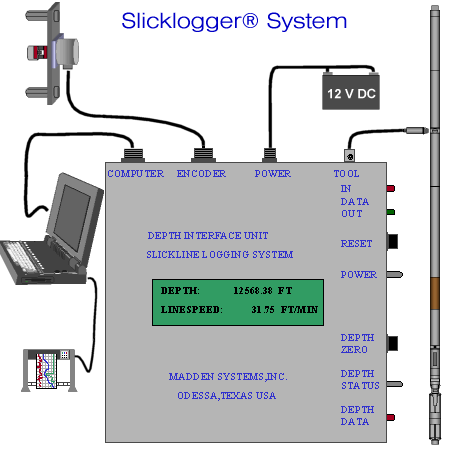
Tubing
Checks - Leak Detection - Gas Lift Analysis
An excellent use for the
Slicklogger® PLT Systems is to perform tubing checks. It is a quick, economic, and accurate means of identifying tubing
leaks, gas lift leaks, and inoperative gas lift valves. Tubing leaks can be found by mechanical
means but this usually takes days to complete.
The initial costs associated with the mechanical methods are lower and
can appear to be the most cost effective; however, they rarely are, due to the
amount of time needed to define a depth range of +/- 20 feet. PL can tell you within a foot.
Other
practices of data acquisition for gas lift analysis are being replaced by the
dynamically acquired pressure data from a dedicated logging system. Stationary pressure gradient stops have been
used since the conception of pressure gauges (bombs). It is normal procedure to
make gradient stops in and around gas lift mandrel at 500' increments. If you really want to narrow in, you might
have the stops 100' apart in critical areas.
Thus, your resolution of data points is 100 - 500'! The Slicklogger® Systems will supply you a
data point on a per foot basis. In
addition, the other sensors in the tool can identify the conditions within the
tubing at the time the data is acquired.
You don't have to settle for stationary readings 500' apart where your
only control factor is to take long-term reading so that you can average the
data and guess at the conditions during acquisition.

Locating Water Source With Temperature Logs
Production
Logging actually began in the late 1930's with the introduction of temperature
measurements in oil and gas wells.
Production logging strings have become more sophisticated at qualifying
and quantifying flow profiles in the wellbore.
Basically, the production logging string obtains a density and a flow
velocity measurement that are then introduced to programs that will calculate
where the fluid is entering, the type of fluid, and the quantity of the
entry. Flow characteristics such as
turbulence, circulating fluids, and slugging can influence spinner and density
type sensors rendering the data useless for analysis.
Although
very accurate and reliable, temperature is often neglected as the proper tool
for identifying water source.
Temperature can be measured accurately no matter what the flow
conditions of the well. Temperature
logs also tend to reflect long-term behavior in a well, not just current
conditions.
If some
of the produced fluid is water, it is not enough to just know where the water
is entering. It is critical to know its
origination. Is it fingering in with
the production, channeling from above or below by the cement, coning from above
or below via the formation, or is the reservoir depleted and "water
drive" the source. Finding the
source of water will typically require the investigation to be carried out
behind the pipe. The most reliable way
to find fluid movement behind the pipe is to measure the temperature changes
created by that movement.
To
interpret the temperature log, one must understand the various factors that
influence temperature behavior in the well.
These include the natural temperature of the formations penetrated by
the well, heat conductivity between the well and surrounding formation,
diffusivity of mechanicals such as packers, heat convection attending fluid
flow, and thermal changes of fluids under dynamic conditions.
The
generation and dissipation of the earth’s heat is ad infinitum. The heat flux from the core travels to the
surface through the various lithologies.
This geothermal profile will vary from area to area and the slope of the
geothermal temperature versus the depth (referred to as geothermal gradient) will
vary from formation to formation. The
geothermal gradient depends on the thermal conductivity of the lithology. The higher the thermal conductivity, the
more easily the heat is transported through the rock. Though varying at
different locations, the gradient will typically be 1o F/100 ft. to
2.5 o F/100 ft. This
gradient is key and becomes the reference when interpreting temperature logs.
While the fluids trapped within the earth remain static, the geothermal
gradient will be normal for that area.
Once the fluid moves, it will transport some of the temperature from its
depth of origin. When the fluid moves
it will change the temperature around the borehole where it travels. The new amount of temperature change per
depth then becomes a dynamic temperature gradient. The rate or slope of this temperature change will be steeper near
its origin and gradually move parallel to the normal geothermal slope. Actual temperature at a given depth will
then be different from the normal geothermal temperature.
If the
fluid movement ceases, the temperature in the well will start to move back to
the original geothermal temperature for that area and depth. This "decay" in temperature back
to normal will be determined by the time of the fluid movement, the volume of
fluid and the conductivity between the well and the formation. The "temperature decay" is
extremely useful in qualifying fluid movement and in some cases the movement
can be quantified.
A log
from a water injection well (Figure 1 and Figure 2) demonstrates the use of
temperature decay to interpret logs.
These examples are the same well and same log but different views and
scales.

The well
had been injecting 500 BWPD with an injection pressure of 800 psi and then the
pressure dropped to 500 psi although the injection volume remained the same. The spinner indicates that the water is
exiting the borehole at the top of the upper set of perforations. This temperature survey indicates that the
water is exiting the wellbore at the upper perforations and then channeling up
behind the pipe to the area at 1525 feet.
The temperature is also indicating the long-term behavior mentioned
earlier. Although no water is exiting
the bottom set of perforations, the cool anomaly at the bottom perforations is
a result of the prior injection and full recovery to normal geothermal
temperature is not yet complete. Prior
to injection the temperature in the wellbore is near the normal geothermal
gradient. Once injection begins, the temperature
of the injected fluid will start to change the original temperatures at any
place in the well through which it moves.
This
example well (Figure 2) demonstrates temperature characteristics in the shallow
depths where the injected water is warmer than the geo-temperature. At 1200 ft, in this example, the average
injected water temperature and the well geothermal temperatures are the
same. Above that depth the injected
water is warmer, below that depth the injected water is cooler.
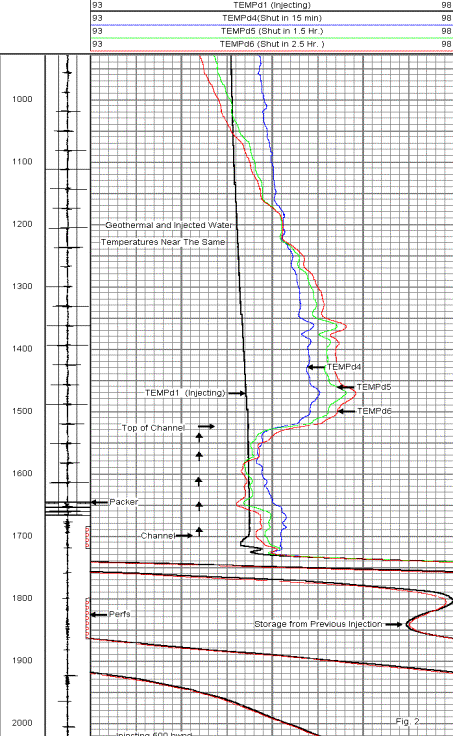
When the
geothermal temperature becomes warmer than the injected water temperature, the
curve and the decay curves "cross".
Typically, the fluid will be cooler than the earth at the depth of entry
to the formation but this must be known for correct interpretations. As more and more fluid invades and is
"stored" in the formation, the temperature there will approach the
temperature of the fluid at the point of injection. Below the point of injection or below the area of storage, the
temperature remains near the normal geothermal temperature.
When
injection is stopped, the well will recover toward the original temperatures
prior to injecting. Determining the
amount of time for recovery takes gives a great deal of information. In the wellbore above the injection zone,
the temperature in the well will recover faster. Over the area of storage, the well will recover much slower
depending on the volume of water injected.
Below any injected water storage, the temperature will have remained
near the norm. Thus, the injecting
temperature curve versus depth of a water injection well will have a steeper
slope and cooler temperature above the injection or storage area and would
recover rapidly to the normal geothermal temperatures below the area of
injection.
In this
example there is no fluid movement at this time below 1730 ft. The shut in temperature curves will become
warmer faster in the area above the injected water but will indicate warming
much slower over the injected interval. Below the injected interval the flowing
and shut in temperatures will be the same.
The log
(Figure 2) indicates that the injected water is exiting the wellbore and
channeling up behind the pipe to1525 ft.
At depths above the channel, the temperature decay is normal. In the channel and storage area, the
temperature first moves toward the average temperature of the injected fluid
and then will decay back to the normal gradient much slower than where there is
no channel or storage. Producing wells
can be more complex because flow in the formation is taking place and heat
transfer from forced convection and conduction, and Joule-Thomson heating or
cooling of the fluid can be significant.
However, the temperature log can be used as a means to evaluate well
characteristics by measuring and analyzing anomalous temperature behavior.
A
producing well with water channeling from below the perforated interval is
shown (Figure 3). The well had been
shut in several days prior to logging. A base temperature run was made with the
well shut in. Then the well was opened
to flow and logging surveys were made at one hour, two hour, and three hour
intervals after flowing the well. The
results show the water moving up behind the pipe from 6075 feet and entering
the wellbore at the perforations. The
fluid warms the area it moves through quickly and each successive pass defines
the source more precisely. Note the
small difference between the shut-in and flowing temperature below any area of
flow. This is due to the release of pressure causing the fluids
to cool. The temperature cools
immediately when the pressure drops and then begins to decay back to
normal. The amount of change in the
area below any fluid movement is dependent on the amount of pressure change
between shut-in and flowing and the rate of that change. It is important to
note that although the absolute temperature changes the slopes of the curves
remain constant.

The fact
that the temperature at 6075 ft. increases to above the normal geothermal
temperature indicates that pressure is driving this fluid and Joule-Thomson
heating is occurring. This heating is
again seen at 5970 ft. when the fluid enters the wellbore. There are also examples of Joule-Thomson
cooling effects at 5932 and 5952 ft. where gas is entering the wellbore. Simplified, if a non-compressible fluid
(water) is moved through an orifice heating will occur. If a compressed fluid (gas) moves through an
orifice then cooling will occur.
Maxim
Technology Limited
Maxim
Engineering Centre,
Vale
Business Park,
Cowbridge,
Vale of Glamorgan,
Wales,
UK.
www.maximtech.co.uk
MAXIM Technology’s range of products
can be deployed on either electric wireline for surface read-out (SRO) or
memory for downhole recording.
MAXIM's High Speed Telemetry interface
(HSTi) system is used to transmit data from downhole tools to a
surface acquisition system and is one of the fastest available for use on
monocable. Inter-tool communication is
available via the Downhole Tool Bus (DTB), which enables very high-speed
communication between tools and downhole data processing.
The High
Capacity Memory Cartridge (HCMC) facilitates Downhole data recording, which is
available with memory in increments of 16 MB for almost unlimited recording
capability.
All
tools are built using approved NACE specification materials (MRO175) for use in
wells containing H2S and/or CO2.
Amongst
other products, Maxim manufactures the world’s shortest 9-sensor production
logging tool (PPL).
Maxim Product Codes and
Description
101 Accelerometer Velocity Tool
Measures changes in tool string velocity (acceleration) along the wellbore axis, and also measures wellbore deviation. Enables correction of data corruption caused by tool yo-yo and stick-slip motion.
102 Casing Collar Locator
Detects joints between lengths
of casing. A special CCL is designed to detect flush-joint casing.
103 Scintillation Gamma Ray
Measures
natural background radiation - used as a depth control device and to tie-in
cased hole logs with openhole logs.
104 Quartz Pressure Tool
Measures
downhole pressure using a quartz pressure gauge.
105 Temperature Tool
Performs
a precision, high-resolution measurement of downhole temperature.
106
Caliper Fullbore Flowmeter
Combines
a two axis caliper to measure wellbore diameter with a flowmeter to measure
fluid flow, and provides lower centralization when deployed with PPL.
107 In-line Flowmeter
Measures flow of fluid in the
well. Small diameter so can measure flow in tubing as well as casing.
108 Radioactive Fluid Density
Tool
Measures
fluid density using a low energy radioactive source, in order to derive fluid
identity (oil/water/gas).
109 Differential Pressure Fluid
Density
Measures fluid density using a
precision differential pressure gauge.
110 Water Hold-up Tool
(sometimes referred to as CWH, capacitance water hold-up)
Measures
hydrocarbon / water ratio in the well.
111 Centralizer
Centralizes the tool string in
the wellbore.
112 Caliper
Measures diameter of casing or
tubing.
113 Knuckle Joint
Allows decoupling of section of
a logging tool string in order to run some elements centralized and others
eccentred.
114 Swivel Joint
Allows rotational movement
between the cable head and the toolstring below to allow cable to ‘untorque’ as
it is run in the well.
115 Head Tension Voltage Tool
Measures tension and compression
at the tool head as well as tool head voltage.
116 Addressable Release Tool
Enables engineer-controlled
release of part of a cased hole toolstring in the event that the toolstring
becomes stuck.
117 Pocket Production Logging
Tool
Ultra-short, all-in-one
production logging tool. The basic unit measures pressure, temperature, gamma
ray, fluid capacitance, and CCL.
118 Horizontal Fluid Profile
Tool
Used to
derive fluid identity and flow rates in highly deviated or horizontal wells.
119 Orientation Velocity Tool
Measures tension and compression
at the tool head, tool head-voltage, deviation and tool orientation.
125 High Speed Telemetry
Interface
Fully
digital mono/co-axial cable telemetry system comprising downhole electronic
cartridge (HSTC) and surface panel (HSTP) or DELTA surface system
126 Digital Evaluation Logging
Tool Acquisition System
Highly compact computer based
surface system used to acquire log data in real time. Employs a Windows-based system for ease of use and flexibility.
127 Memory Crossover Tool
Enables
a third party memory tool to be run with Maxim
downhole tools.
128 Vibration Monitoring Tool
Measures
vibration occurring in a stuck drill pipe downhole.
129 Fluid Identification Tool
Identifies the proportion of
each fluid type (oil/water/gas) in order to derive the volumetric flow rate of
each component in the well.
130 Fluid Diverter Tool
Forces
all flow from a low flow rate well through a small orifice in order to make
accurate measurements of flow rate and fluid identity.
131 High Capacity Memory
Cartridge
Records log data downhole for
later retrieval and viewing on a PC.
132 Fixed Cage Flowmeter
A bottom
flowmeter with a fixed diameter impeller used where a CFF is not appropriate.
133 Multifinger Caliper
A
caliper with a high radial density of measuring fingers used to monitor
casing/tubing corrosion, erosion and wear.
134 Electromagnetic Thickness
Tool
Measures
the metal loss in corroded/eroded downhole tubulars. Combinable with the MFC.
Oildata
Wireline Services
Oildata
Wireline Services Limited
Plot
282, Trans Amadi Industrial Layout
PMB 074
Port
Harcourt, Rivers State
Nigeria
http://www.oildatainc.com/index.html
Introduction
Oildata's Production Logging
Tool has been used to successfully record single and multi-phase PLT surveys on
numerous horizontal and vertical wells in Nigeria. The tool simultaneously records measurements from up to twelve
(12) independent, high-resolution sensors.
Description
The
Memory/Real-Time Production logging tool simultaneously records data from up to
twelve different production log sensors (e.g. Spinner, Gradiomanometer,
Capacitance, Gamma Ray, Temperature, Caliper etc.) in addition to the Casing
Collar Locator and Quartz Pressure. In
memory mode, log data are stored in a downloadable memory tool. The tool string can be deployed on slickline,
coiled tubing or e-line depending on the logistics. In memory mode, depth correlation is achieved by simultaneous
recording of the depth and time via an electronic encoder and depth-time
interface and correlating the resulting output logs (e.g. Gamma Ray and Casing
Collars) to the existing open hole logs.
High-resolution
measurements are taken over a sample interval as small as 10 samples a second
and stored in non-volatile memory which has capacities as large as 50Mb. Data files and logs can be transmitted using
a modem link to any location from the well site. Interpretation is performed at the well site with aid of a
computer-based Cased Hole interpretation package. Final interpretation is done at our Computer Centre. It is virtually impossible to distinguish
data acquired in Memory or Real time modes.
Applications
·
Determination
of the contribution of individual zones to total production. Determination of
quantitative flow rates
·
Accurate
measurement of after flow in high permeability reservoirs.
·
Well
performance evaluation.
·
Water
Injection/Dump Flood profiles
·
Identifying
fluid entries and exits.
·
Identifying
anomalous flow behind casing or tubing.
·
Determination
of scale buildup in casing or tubing.














